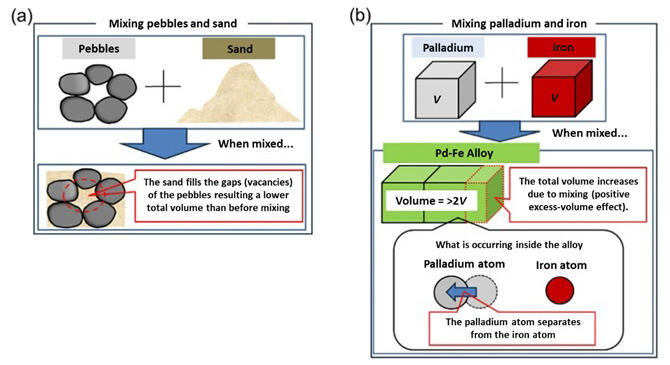A joint research group including Assistant Professor Manabu Watanabe, Researcher Tomonori Tanaka and Associate Professor Yoshihiro Gohda from the Department of Materials Science and Engineering at Tokyo Institute of Technology, in collaboration with Senior Researcher Yasumasa Takagi from the Center of Synchrotron Radiation Research at the Japan Synchrotron Radiation Research Institute, Professor Tetsuya Nakamura and Professor Masaki Takata from the International Center for Synchrotron Radiation Innovation Smart (SRIS) at Tohoku University, and Professor Hiroyuki Fukuyama from the Institute of Multidisciplinary Research for Advanced Materials, Tohoku University, announced that they have successfully explained the origin of the unexplained excess volume effect that occurs in Pa-Fe alloys during mixing from the electronic state. It is expected that these results will be applied to the development of metal products by increasing the accuracy of numerical simulations of molten metals used in casting. The results were published in the international academic journal Acta Materialia on February 1.

(b) When palladium and iron atoms are mixed: The volume increases due to mixing (positive excess-volume effect). The attraction between the palladium atoms in the alloy (metallic bonding) is weakened and they try to separate from the iron atoms. This causes an increase in volume.
Provided by Tokyo Institute of Technology
When two metals with different atomic sizes are mixed to form an alloy, the volume generally becomes smaller than before mixing, but alloys of palladium and iron conversely cause an increase in volume from that before mixing (excess-volume effect). The research group has adopted a new method that focuses on the behavior of "electrons," which are responsible for attracting atoms to each other. Theoretical calculations of the electronic state of this alloy and x-ray photoelectron spectroscopy measurements using high-brilliance synchrotron radiation x-rays indicate that the force that attracts Pd atoms to each other (metallic bond) is weakened. The weakening of the metallic bond increases the volume of the Pd-Fe alloy, resulting in the volume expansion effect.
Theoretical calculations (first principles calculations) were used to estimate the electronic state of the Pd-Fe alloy as it undergoes order-disorder transition and exhibits a large excess volume effect that has not been explained in previous studies. The change in the electronic state of Pd predicted by the theoretical calculations tended to be equal to the estimate from hard X-ray photoelectron spectroscopy measurements at the large synchrotron radiation facility SPring-8 BL46XU. The theoretical calculations agreed with the experimental results.
Watanabe said, "This is fundamental research into molten metals that has been conducted for over 80 years. It was thought that research into this area was completed. In these findings, thanks to the cooperation of researchers at SPring-8 and other synchrotron radiation facilities, we were able to gain new insights into the correlation between electron theory and thermophysical properties. In the future, we plan to expand our research by using the 3GeV high-brilliance synchrotron radiation facility (NanoTerasu), which will begin operation at the new Aobayama campus of Tohoku University from FY2024. This will allow us to further deepen our research into the relationship between molten metals and electron theory."
Journal Information
Publication: Acta Materialia
Title: Clarification of origin of positive excess volume of Pd-Fe binary alloys by using first-principles calculations and HAXPES
DOI: 10.1016/j.actamat.2024.119718
This article has been translated by JST with permission from The Science News Ltd. (https://sci-news.co.jp/). Unauthorized reproduction of the article and photographs is prohibited.




